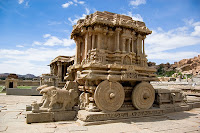ONE DAY TRIPS
1. Badami with Aihole, Pattadkal & Banshankari: The main attractions of Badami are its caves. There are four main caves. The first one is dedicated to Shiva. It was excavated by the Chalukyas in 550 AD. The second one is dedicated to Vishnu. In this cave there are statues of Vishnu avatars like Varaha, the boar or Krishna . The third cave is also dedicated to Vishnu and the last one is a cave with Jain representations.
2. Kittur Fort, Devgaon & Halshi:
Kittur is a fort located in the Karnataka state of India, it is the former capital of a minor principality as well as a major archaeological site. It was held by the Desai Marathas of Kittur, as well as Rani Chennamma, a Lingayat woman warrior of Karnataka who revolted against the British in 1824. Kittur reached its zenith during the Mallasarja Desai. The place has a Nathapanthi matha in police line area, and temples of Maruti [in fort], Kalmeshwara, Dyamavva and Basavanna, the last named a later Chalukyan monument now completely renovated.
Halasi is famous for having been the capital of a branch of Kadamba Dynasty. The town is rich in historical monuments and temples and is near Khanapur. Halasi is in Background of Western Ghats in lush green atmosphere. It was the second capital of the Kadambas of Banavasi. The huge Bhuvaraha Narasimha temple has tall images of Varaha, Narasimha, Narayana and Surya. The place has a fort, and also temples of Gokarneshswara, Kapileshwara, Swarneshwara and Hatakeshwara.
3. Bijapur: Rich in historical attractions important places of interest are Gol Gumbaz, Barakaman, Shiva Statue
Gol Gumbaz: This is the most famous monument in Bijapur. It is the tomb of Mohammed Adil Shah (ruled 1627–1657). It is the second largest dome ever built, next in size only to St Peter's Basilica in Rome. A particular attraction in this monument is the central chamber, where every sound is echoed seven times. Another attraction at the Gol Gumbaz is the Whispering Gallery, where even minute sounds can be heard clearly 37 metres away. Gol Gumbaz complex includes a mosque & a Naqqar Khana (a hall for the trumpeters now it is used as museum).
Barakaman (Ali Roza-II) A mausoleum of Ali Roza built in 1672. It was previously named as Ali Roza, but Shah Nawab Khan changed its name to Bara Kaman as this was the 12th monument during his reign. It has now seven arches and the tomb containing the graves of Ali, his queens and eleven other ladies possibly belonging to the Zenana of the queens.
Shiva Statue: The 85-foot tall statue is a three-km drive on
4.
Mahalaxmi Temple: The Shri Mahalakshmi Temple of Kolhapur in Maharashtra, India, is one of the Shakti Peethas listed in various puranas of Hinduism. According to these writings, a Shakti Peetha is a place associated with Shakti, the goddess of power. This Shakti Peetha is of special religious significance being one of the six places where it is believed that one can either obtain salvation from desires or have them fulfilled. The temple takes its name from Mahalakshmi, the consort of Vishnu, and it is believed that the divine couple reside in the area.
New Palace: New Palace is located in
 |
| Great Warrior Bajiprabhu Deshpande |
 |
| At Kaneri Math |
Kaneri Math: A newly developed cultural museum has fine imitations of various cultures & traditions relating to Karnataka & Maharashtra.
TWO DAYS TRIPS
Perfect over night Historical excursion would be
- Badami, Aihole & Pattadkal topped up with Kudalsangam & Hampi, or
- Badami, Aihole & Pattadkal topped up with Almatti Dam (Rock Garden) & Bijapur
Kudalsangam most historic place since around 800 years. The famous rivers Krishna and Ghataprabha merge here and flows towards Srisaila in AP. An inscription in the temple of 1213 A.D. records a gift to the god Acheshvara. Another stone record of 1160 A.D. refers to land grant to deities, Kaleshvara and Achesvara.
Hampi (Humpi or Hampe) is both a historic & religious place in India India












